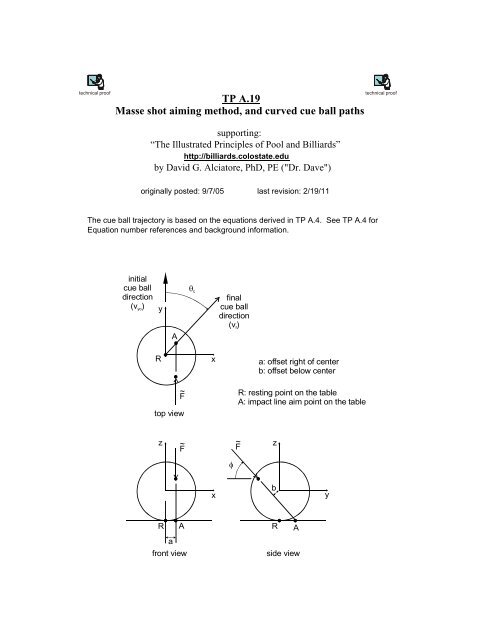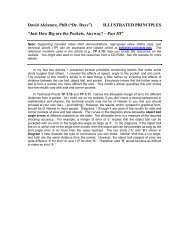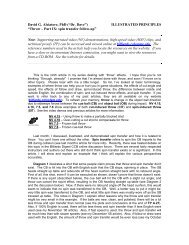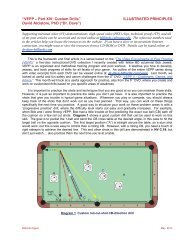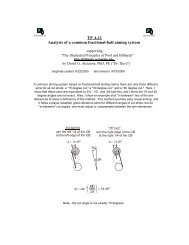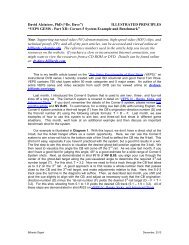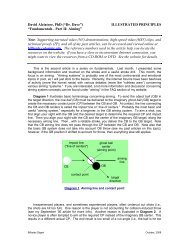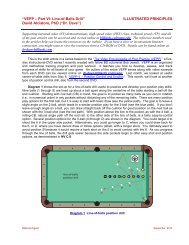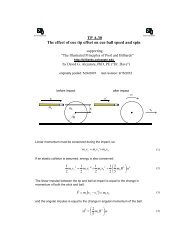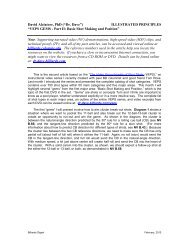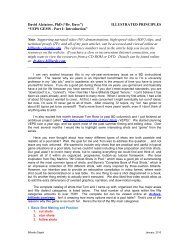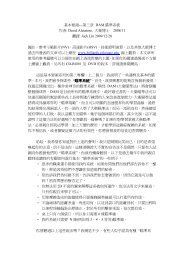TP A.19 - Illustrated Principles of Pool and Billiards
TP A.19 - Illustrated Principles of Pool and Billiards
TP A.19 - Illustrated Principles of Pool and Billiards
Create successful ePaper yourself
Turn your PDF publications into a flip-book with our unique Google optimized e-Paper software.
technical pro<strong>of</strong><br />
<strong>TP</strong> <strong>A.19</strong><br />
Masse shot aiming method, <strong>and</strong> curved cue ball paths<br />
supporting:<br />
“The <strong>Illustrated</strong> <strong>Principles</strong> <strong>of</strong> <strong>Pool</strong> <strong>and</strong> <strong>Billiards</strong>”<br />
http://billiards.colostate.edu<br />
by David G. Alciatore, PhD, PE ("Dr. Dave")<br />
originally posted: 9/7/05 last revision: 2/19/11<br />
The cue ball trajectory is based on the equations derived in <strong>TP</strong> A.4. See <strong>TP</strong> A.4 for<br />
Equation number references <strong>and</strong> background information.<br />
initial<br />
cue ball<br />
direction<br />
(v )<br />
yo<br />
y<br />
R<br />
z<br />
R A<br />
a<br />
A<br />
F ~<br />
top view<br />
front view<br />
c<br />
x<br />
x<br />
final<br />
cue ball<br />
direction<br />
(v )<br />
f<br />
F ~ F ~<br />
<br />
a: <strong>of</strong>fset right <strong>of</strong> center<br />
b: <strong>of</strong>fset below center<br />
R: resting point on the table<br />
A: impact line aim point on the table<br />
z<br />
b<br />
R A<br />
side view<br />
y<br />
technical pro<strong>of</strong>
The cue ball is assumed to be struck in the y direction with the angled impulse as shown<br />
above. From linear impulse <strong>and</strong> momentum, the initial cue ball speed components, after cue<br />
stick impact, are:<br />
vxo<br />
0<br />
~<br />
F<br />
v yo cos <br />
m<br />
v cos<br />
where v e is the effective speed <strong>of</strong> a straight-on impact.<br />
From angular impulse <strong>and</strong> momentum, the spin components <strong>of</strong> the cue ball about the x <strong>and</strong> y<br />
axes, after cue stick impact, are related to the impulse according to:<br />
~ 2 <br />
Fb I <br />
2<br />
xo mR <br />
5 <br />
~<br />
2 <br />
Fa sin 5 <br />
e<br />
xo<br />
2<br />
Iyo mR yo<br />
Therefore, the initial spin components, using Equation 2, can be written as:<br />
5ve<br />
xo b 2<br />
5<br />
2R<br />
5<br />
sin 2<br />
2<br />
a<br />
ve R<br />
( 1)<br />
( 2)<br />
( 3)<br />
( 4)<br />
( )<br />
yo ( 6)<br />
We can now find the final cue ball direction from Equation 23 in <strong>TP</strong> A.4:<br />
tan<br />
c<br />
5v<br />
<br />
5v<br />
xo<br />
yo<br />
2R<br />
2R<br />
yo<br />
xo<br />
5ve<br />
0 asin<br />
R<br />
asin<br />
<br />
<br />
5ve<br />
5v<br />
b<br />
R<br />
e cos <br />
cos<br />
R<br />
b As proved by Coriolis, the final cue ball direction can also be predicted from the geometry<br />
shown in the illustration above. From the top view, the final cue ball direction can be<br />
expressed as:<br />
tan<br />
a<br />
c ____ <br />
RA<br />
( 7)<br />
( 8)
From the side view in the illustration above, it can be shown (see the figure below) that:<br />
Equation 9 can be rearranged to give:<br />
b RAsin<br />
R cos <br />
b<br />
<br />
____<br />
( 9)<br />
<br />
RA<br />
<br />
R<br />
____ R cos<br />
RA 10<br />
sin<br />
Using Equation 10 in Equation 8 results in the same expression as Equation 7. Therefore, the<br />
aiming method proposed by Coriolis is shown to be valid. Note that the friction between the<br />
ball <strong>and</strong> the table during cue stick impact is is not accounted for in this analysis, but Coriolis<br />
also showed that this friction has no effect on the final cue ball direction.<br />
With typcial conditions, the final CB angle usually comes up a little short <strong>of</strong> the angle<br />
predicted by the Coriolis method. This could be due in part to squirt <strong>and</strong> multiple-body<br />
collision effects associated with jamming the cue ball between the tip <strong>and</strong> slate.<br />
Now we can define the cue ball trajectory based on the analyses above <strong>and</strong> in <strong>TP</strong> A.4.<br />
NOTE: All parameters are expressed in metric (SI) equivalent values for dimensionless analysis<br />
ball properties:<br />
D <br />
2.25in m<br />
R <br />
D<br />
2<br />
D 0.057<br />
coefficient <strong>of</strong> friction between the cue ball <strong>and</strong> table cloth:<br />
gravity<br />
μ 0.2<br />
g<br />
g g <br />
9.807<br />
m<br />
s 2<br />
( )
From Equation 1, 2, 5, <strong>and</strong> 6 above,<br />
vxo 0<br />
ωxoveb 5v e<br />
2R 2<br />
b<br />
<br />
vyoveϕ vecos( ϕ)<br />
ωyovea ϕ<br />
5v e<br />
2R 2<br />
asin( ϕ)<br />
<br />
From Equation 14 in <strong>TP</strong> A.4,<br />
vCoxvea b ϕ<br />
vxo Rωyo vea ϕ<br />
<br />
vCoyvea b ϕ<br />
vyoveϕ Rωxo veb vCoxvea b ϕ<br />
2<br />
<br />
vCo vea b ϕ<br />
From Equation 20 in <strong>TP</strong> A.4,<br />
<br />
2v Co vea b ϕ<br />
Δtvea b ϕ<br />
<br />
7μg From Equations 21 <strong>and</strong> 22 in <strong>TP</strong> A.4,<br />
<br />
2<br />
vCoy vea b ϕ<br />
<br />
<br />
vCox vea b ϕ<br />
vxf vea b ϕ<br />
vxo μg Δt<br />
v<br />
vCo vea b ϕ<br />
ea b ϕ<br />
<br />
<br />
<br />
vCoy vea b ϕ<br />
vyf vea b ϕ<br />
vyoveϕ μg Δt<br />
v<br />
vCo vea b ϕ<br />
ea b ϕ<br />
From Equations 24 <strong>and</strong> 25 in <strong>TP</strong> A.4,<br />
vxot xc vea b ϕ t<br />
ycvea b ϕ t<br />
<br />
vyo veϕ <br />
<br />
b ϕ<br />
μgvCox vea b ϕ<br />
t<br />
2v Co ve a<br />
2<br />
<br />
<br />
t<br />
<br />
b ϕ<br />
μgvCoy vea b ϕ<br />
t<br />
2v Co ve a<br />
2
From the analysis in <strong>TP</strong> A.4, the entire cue ball path is defined by:<br />
xv ea b ϕ t<br />
ΔT Δtvea b ϕ<br />
xcvea b ϕ t<br />
if t ΔT<br />
xcvea b ϕ ΔT<br />
vxf vea b ϕ(<br />
t ΔT)<br />
<br />
yv ea b ϕ t<br />
ΔT Δtvea b ϕ<br />
ycvea b ϕ t<br />
if t ΔT<br />
ycvea b ϕ ΔT<br />
vyf vea b ϕ(<br />
t ΔT)<br />
<br />
From Equation 7 above, the final cue ball angle can be found with:<br />
θc( ab ϕ)<br />
angle( Rcos( ϕ)<br />
basin(<br />
ϕ)<br />
)<br />
Parameters used in plots below:<br />
T 5<br />
t 00.01 T<br />
number <strong>of</strong> seconds to display<br />
0.01 second plotting increment<br />
otherwise<br />
otherwise<br />
Equation for the final direction: Equation for the ball (for scale)<br />
xf () t<br />
t<br />
T 2 xball t ( ) Rcos t π<br />
<br />
T 2<br />
yf ( ab ϕ t)<br />
<br />
xf () t<br />
tanθc( ab ϕ)<br />
<br />
yball( t)<br />
R sin t π<br />
<br />
<br />
T 2<br />
various effective impact speeds (in mph, converted to m/s):<br />
v1 <br />
6mph m<br />
v2 <br />
9mph m<br />
v3 <br />
s<br />
s<br />
12mph m<br />
s
ϕt <br />
yv<br />
1<br />
ab ϕt yv 2 a<br />
0.6<br />
yv<br />
3<br />
ab ϕt 0.4<br />
y<br />
f<br />
( ab ϕt) y<br />
ball<br />
() t<br />
0.2<br />
<br />
b ϕt b ϕt yv<br />
1<br />
ab ϕt yv 2 a<br />
yv 3 a<br />
y<br />
f<br />
( ab ϕt) y<br />
ball<br />
() t<br />
ϕ 75deg a 0.25R b 0.25R 0<br />
0 0.2 0.4 0.6<br />
0.2<br />
0<br />
0.2<br />
0.4<br />
xv 2<br />
a <br />
<br />
xv<br />
1<br />
abϕt bϕt xv 3<br />
abϕt x f<br />
() t x<br />
ball<br />
() t<br />
ϕ 85deg a 0.25R b 0.25R 0 0.2 0.4 0.6<br />
xv 2<br />
a <br />
<br />
xv<br />
1<br />
ab ϕt b ϕt xv 3<br />
ab ϕt x f<br />
() t x<br />
ball<br />
() t
Comparison <strong>of</strong> draw <strong>and</strong> follow shot swerve for a medium-fast-speed shot under<br />
typical ball <strong>and</strong> table conditions:<br />
v <br />
6mph m<br />
s<br />
a 0.5Rcos( 45deg) bdraw a bfollow a<br />
ϕdraw 4deg ϕfollow 3deg initial aiming line with a typical amount <strong>of</strong> squirt (2 degrees):<br />
xaim() t<br />
<br />
b follow<br />
ϕ follow<br />
t<br />
yva b draw<br />
ϕ draw<br />
t<br />
yva<br />
y<br />
aim<br />
() t<br />
t<br />
y<br />
T<br />
aim() t <br />
2<br />
1.5<br />
1<br />
0.5<br />
same amount <strong>of</strong> English for both:<br />
1:30pm (follow) or 4:30pm (draw)<br />
same amount <strong>of</strong> top or bottom spin for both<br />
slightly higher cue elevation for the draw shot,<br />
but typical values<br />
xaim() t<br />
tan( 2deg) 0<br />
0 0.05 0.1 0.15 0.2<br />
xva <br />
xva b draw<br />
ϕ draw<br />
t<br />
b follow<br />
ϕ follow<br />
t<br />
x<br />
aim<br />
() t<br />
The draw shot exhibits more "effective squirt" (the net effect <strong>of</strong> both squirt <strong>and</strong> swerve, AKA<br />
squerve) over the shorter shot distances (0-4.5 ft); but, over longer shot distances (>4.5 ft), the<br />
follow shot exhibits more "effective squirt." The crossover distance (4.5 ft) depends on shot<br />
speed <strong>and</strong> ball/table conditions.<br />
Here are the final cue-ball trajectory angles after sliding ceases <strong>and</strong> rolling begins:<br />
2.193 deg<br />
θc ab drawϕdraw<br />
<br />
0.784 deg<br />
θc ab followϕfollow
Final cue ball angle for various cue stick elevations:<br />
θ<br />
c<br />
( ab ϕ)<br />
deg<br />
150<br />
100<br />
50<br />
a 0.25R b 0.25R ϕ 0deg1 deg 90deg 0<br />
0 20 40 60 80 100<br />
ϕ<br />
deg


